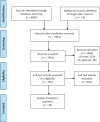Routine testing for blood-borne viruses in prisons: a systematic review
- PMID: 26219884
- PMCID: PMC4668329
- DOI: 10.1093/eurpub/ckv133
Routine testing for blood-borne viruses in prisons: a systematic review
Abstract
Background: People in prison have a higher burden of blood-borne virus (BBV) infection than the general population, and prisons present an opportunity to test for BBVs in high-risk, underserved groups. Changes to the BBV testing policies in English prisons have recently been piloted. This review will enable existing evidence to inform policy revisions. We describe components of routine HIV, hepatitis B and C virus testing policies in prisons and quantify testing acceptance, coverage, result notification and diagnosis.
Methods: We searched five databases for studies of both opt-in (testing offered to all and the individual chooses to have the test or not) and opt-out (the individual is informed the test will be performed unless they actively refuse) prison BBV testing policies.
Results: Forty-four studies published between 1989 and 2013 met the inclusion criteria. Of these, 82% were conducted in the USA, 91% included HIV testing and most tested at the time of incarceration. HIV testing acceptance rates ranged from 22 to 98% and testing coverage from 3 to 90%. Mixed results were found for equity in uptake. Six studies reported reasons for declining a test including recent testing and fear.
Conclusions: While the quality of evidence is mixed, this review suggests that reasonable rates of uptake can be achieved with opt-in and, even better, with opt-out HIV testing policies. Little evidence was found relating to hepatitis testing. Policies need to specify exclusion criteria and consider consent processes, type of test and timing of the testing offer to balance acceptability, competence and availability of individuals.
© The Author 2015. Published by Oxford University Press on behalf of the European Public Health Association.
Figures
References
-
- House of Commons Committee of Public Accounts. Ministry of Justice and National Offender Management Service: Managing the Prison Estate. London: The Stationery Office Limited, 2014.
-
- House of Lords Select Committee on HIV and AIDs in the United Kingdom. No vaccine, no cure: HIV and AIDS in the United Kingdom. London: The Stationery Office Limited, 2011.
-
- Department of Health. Health Protection in Prisons: 2010-2011 Report. London: Department of Health, 2012.
-
- Public Health England, Health Protection Scotland, Public Health Wales, HSC. Hepatitis C in the UK: 2013 Report, 2013. Available at: http://www.hpa.org.uk/webc/HPAwebFile/HPAweb_C/1317139502302 (11 July 2015, date last accessed).
-
- Health Protection Agency, Health Protection Services Prison Network. Health Protection Services 2012 Standards for HPUs in relation to HP in Prisons, 2012. Available at: http://www.hpa.org.uk/webc/HPAwebFile/HPAweb_C/1317135290134 (11 July 2015, date last accessed).
Publication types
MeSH terms
Grants and funding
LinkOut - more resources
Full Text Sources
Other Literature Sources
Medical
Miscellaneous



